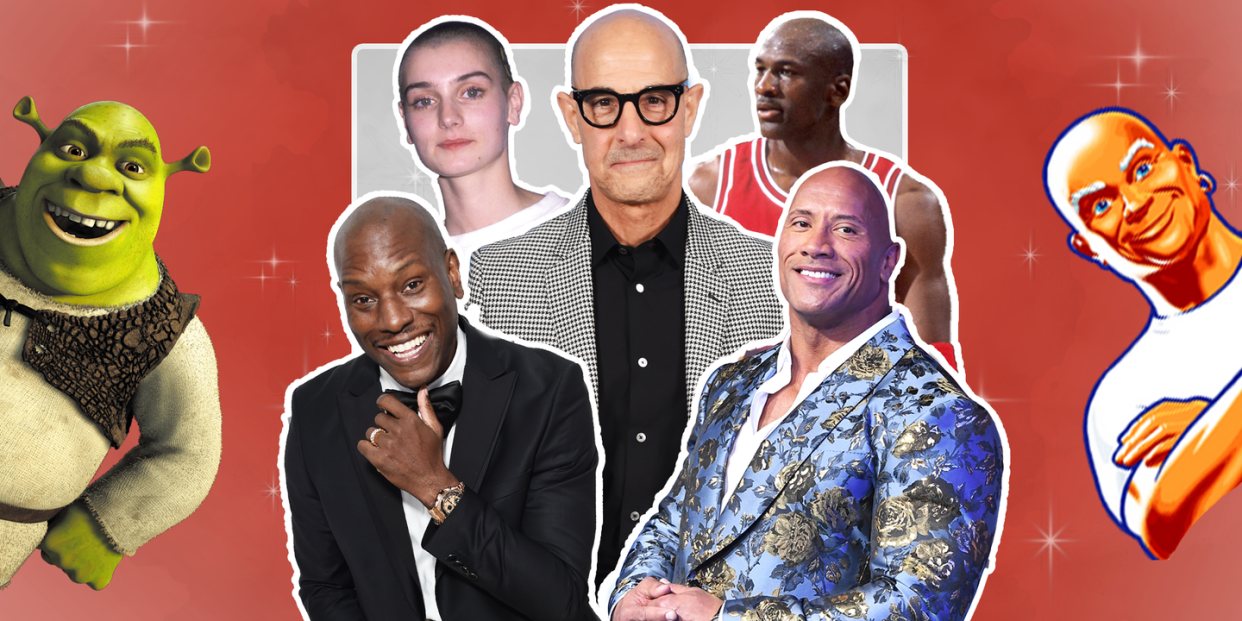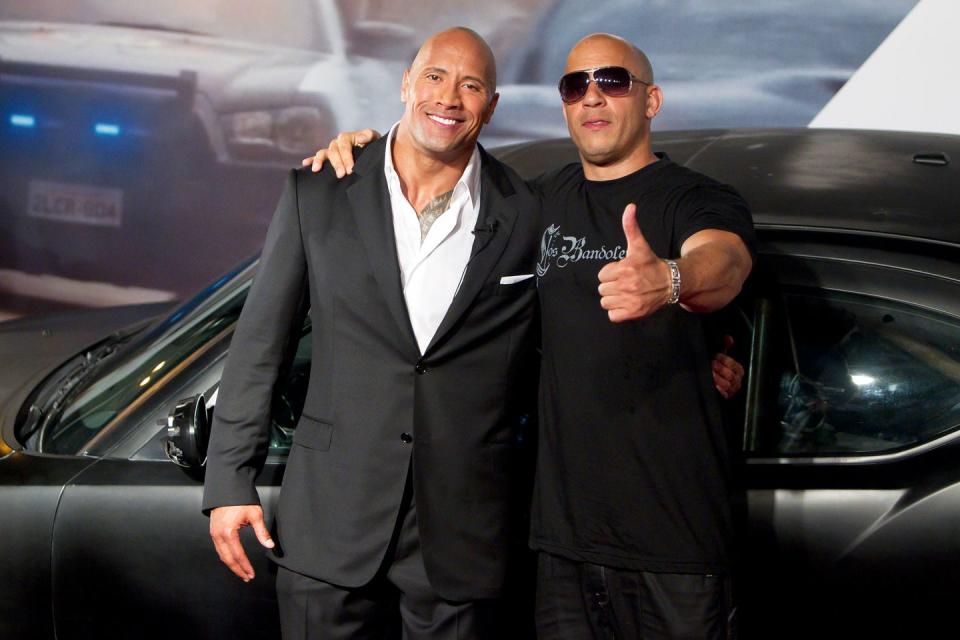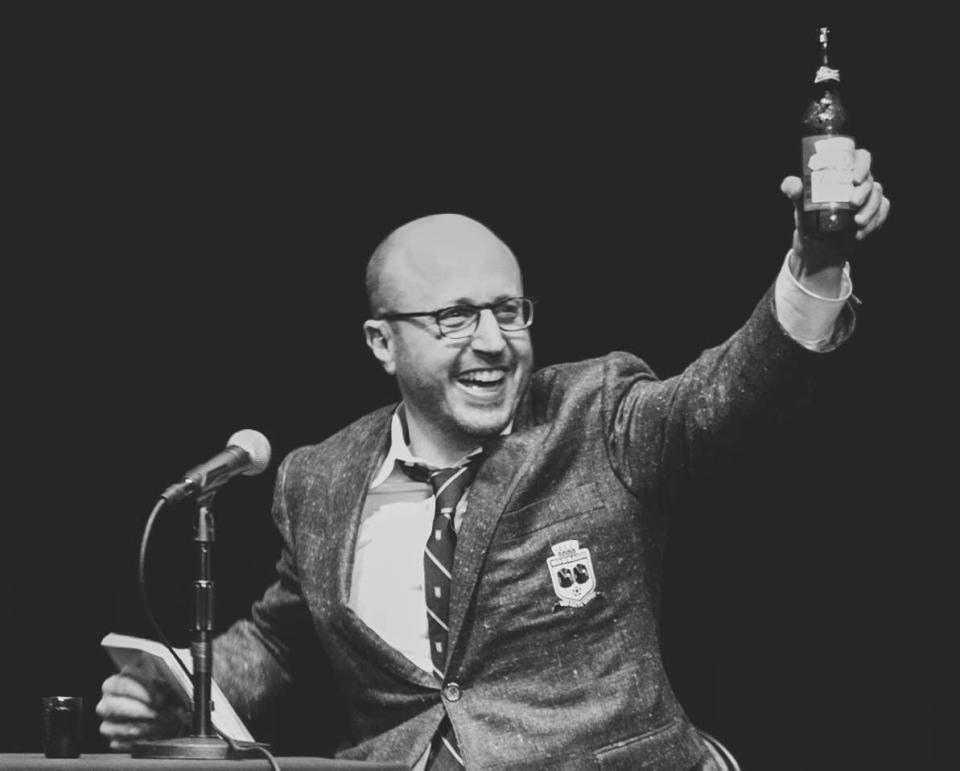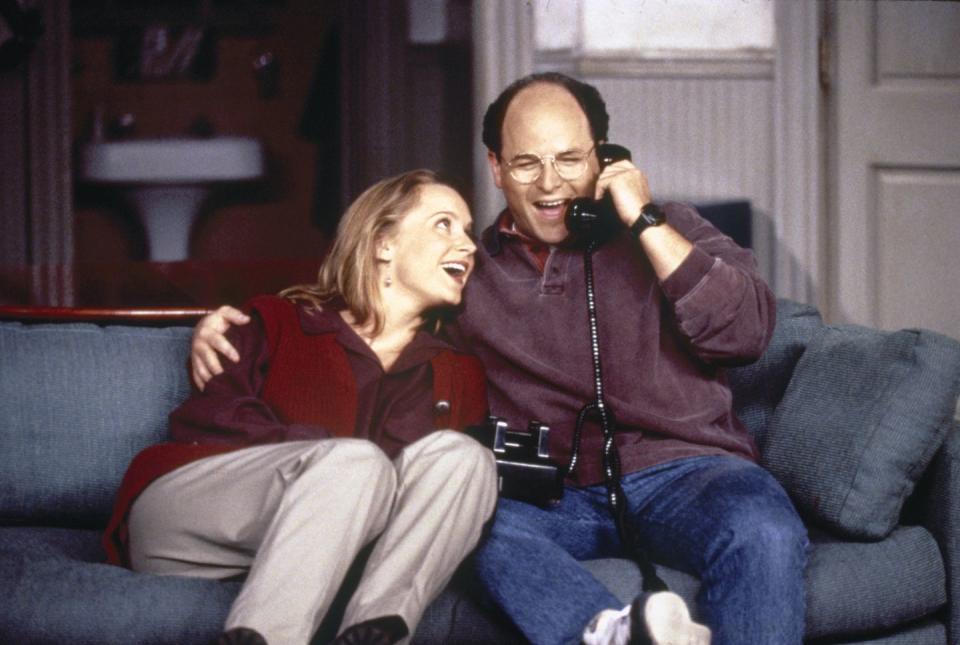Welcome to the Summer of the Power Bald

“Hearst Magazines and Verizon Media may earn commission or revenue on some items through the links below.”
Shrek is an iconic power bald. So is RuPaul, host of RuPaul’s Drag Race All Stars. But they're far from alone in their glistening glory right now. Travis Barker is currently Kourtney Kardashian’s power bald boyfriend. Sean Evans is the power bald host of Hot Ones, while Stanley Tucci’s effortless gravitas in Searching for Italy is simply hot. And don’t forget the bald domination film franchise Fast & Furious, which has featured the glorious hairless heads of Dwayne “The Rock” Johnson, Jason Statham, Tyrese Gibson and Vin Diesel. This month, Gibson and Diesel are shining once again in theaters with F9.
Welcome to the world of power balds, a harried yet hairless community in a state of transition. In fact, the summer of 2021 may just be peak power bald season with Adam Levine embracing the no-hair, self-care style, four-time World's Strongest Man champion Brian Shaw looking sleek as he deadlifts a Hyundia SUV in a car commercial, and the WWE's Brock Strowman a.k.a Adam Scherr posting extra-heady workouts on Instagram.
For the uninitiated, power bald is a surging movement of men who’ve shaved off their insecurities about being bald. While baldness has always existed, a recent cultural shift both on screen and off has shown the strength in grooming to a simple, sleek appearance. One that allows worth and beauty to be defined by principles other than the lusciousness of one’s mane or the uniformity of their crew cuts.

To be clear, power balds are not Homer Simpsons. They’ll happily part with those two remaining hairs to embrace their smooth heads. They aren’t Voldemorts either. Their baldness is not the result of too much toxic masculinity. In fact, some of the most honorable power balds aren’t men at all. Black Panther’s Dora Milaje epitomizes the term, just like Sinéad O’Connor. As does Gossip Girl's newest queen bee Julien Calloway, played by Jordan Alexander. A power bald has power. They’re proud of it. But, most importantly, they’re trying to wield it responsibly.
“Someone who is power bald, it’s about the self-confidence in which you carry yourself,” Roger Bennett, co-host of the TV show and podcast Men in Blazers alongside fellow “bald bloke” Michael Davies, tells Men’s Health.
The two brits living stateside are the unofficial architects of the term power bald if for no other reason than there’s little documentation online of anyone else saying it. They’ve been using the phrase since roughly 2016, making it still an insider-y expression. There’s few Instagram hashtags or Reddit mentions. Urban Dictionary has no related entries.

But for Men in Blazers and their nearly 231,000 Twitter followers, the term is canon. Bennett says they’ve received hundreds of letters pertaining to baldness since talking about it on their platforms. They often bestow the title of “power bald” onto their favorite smooth soccer players like Pep Guardiola and Zinedine Zidane. “It’s probably the one thing that really bonds us, other than our love of football and America,” Bennett says.
As “a third-generation bald bloke,” Bennett had no choice but to appreciate his ever-thinning hairline. Balding had always felt inevitable to him, so he decided to own that. In doing so, and being open to speaking about it, he’s turned what might otherwise feel like a source of shame into something more empowering.

In fact, Bennett is so proud of being a power bald that he questions the implications set by a certain sports figures who fight the fallout. In 2016, former Chicago Bears linebacker Brian Urlacher began appearing on billboards and in testimonials for Restore, a hair transplant company. If you’ve driven on the tollway to O’Hare airport just outside of Chicago in recent years, you’ve likely seen a billboard of Urlacher with new turf atop his head. Baseball Hall of Famer Ryne Sandberg and Pro Football Hall of Famer Deion Sanders also became Restore spokespersons alongside other famed retired athletes.
Conquering one’s insecurities is a battle no amount of muscle or IQ score can win, and men should feel agency to change their appearance however pleases them. But there is a far less costly and more bold move available. “Human beings who actually [go bald] with an incredible swagger, those are the characters we’ve always hailed as power bald,” Bennett says.
Don’t get this joke 😢 pic.twitter.com/wkXBROYDHJ
— Men in Blazers (@MenInBlazers) October 11, 2019
At the same time, there is too much invested in treating baldness to totally normalize it, even if it is normal. Hair restoration remains a cornerstone of the male beauty industry. Toupees have gone viral and rebranded as trendy hair replacements. The digital health startup Hims, which recently reached a valuation of $1.6 billion and included former couple Jennifer Lopez and Alex Rodriquez as spokespersons, made its name selling prescriptions for hair loss (and erectile dysfunction).
It might seem easier and economical to simply shave it all off than go through the headache of finding which hair growth solution is most suitable, but doing so is its own hefty commitment. "The simple solution to shaving your head is not a simple solution,” Spencer Kobren, founder of the American Hair Loss Association, a private organization committed to increasing public awareness about the emotional impact of hair loss on men.
Kobren told the New York Times in 2019 he’s taken finasteride, a medication treating hair loss, for 25 years. (It’s worth noting finasteride, also known by the brand name Propecia, can come with notable side effects.) “I wish everyone could just be confident enough to shave off their hair and not worry about it,” Kobren tells Men’s Health. “That would be incredible, but there’s just so many different components as to why guys are uncomfortable with it.”
For many, the act of balding proudly seems to be one of the last holdouts in the body positivity movement, a crusade men are historically reticent to embrace. No surprise here: Men don’t know how to talk about their bodies. “How do we build security as men?” psychiatrist Drew Ramsey, M.D. says. “Great pecs. Great arms. Great hair. Is that what it means to be a secure, mature man?”
The answer is a resounding no, but our culture would tell us otherwise. Take bald jokes, as were recently levied at Prince William and LeBron James. They’re still not considered taboo. The “joke” here is the Samson complex. A fear that, like the biblical character, your strength, virality and agency are all gone once you lose your hair.
But a look at some of the biggest action stars in Hollywood and iconoclast athletes proves the Samson complex is a bust. LL Cool J made balding (and fedoras and bucket hats) cool. Michael Jordan, Kobe Bryant and Mike Tyson proved strength isn’t tied to hair. Gandhi showed fortitude comes within the head, not what’s shown on the outside. And Mr. Clean proved being squeaky clean can be a turn-on.
There's even a YouTube channel called BaldCafe, which produces candid videos of guys shaving it all off that have gone viral, racking up millions of views. Still, Fast and Furious crew aside, the power bald shift isn’t moving quite fast enough in Hollywood.
According to data compiled by media analytics company The Streaming Graduate, bald representation in narrative film and TV comes down to three major categories: villains (Thanos, Darth Maul), action stars (Bruce Willis, British Bruce Willis a.k.a Jason Statham) and cowards (Tobias Fünke, George Costanza). Often, these archetypes intersect such as the mischievous yet bumbling Frank in It’s Always Sunny in Philadelphia or the feeble and sinister Gollum from Lord of the Rings.

Sarah-Mikal, head of analytics and strategy at the Streaming Graduate, says it’s rare to see bald actors in romance or family films. The primary exceptions are The Rock, Vin Diesel and Dave Bautista who’ve all starred in at least one child-friendly action comedy. (Belated justice for The Pacifier.)
Some power bald pioneers are slowly infiltrating the world of male modeling too. Ben Whit is a London-based plus-size model notably featured in a 2019 campaign for UK-based menswear retailer Jacamo. “I’m more of a niche market,” he says. “With the plus-size industry being so small still at the moment, it is harder to get work.”
Though the market cooled off recently for Whit (losing modeling work because of the pandemic certainly didn’t help), he’s focused on changing the perception of what baldness can look like whether it’s on Instagram, in interviews or in fashion spreads. He’s hoping “more men will realize, 'Actually, I don't have to look like [the standard model] to be happy. He's happy the way he looks, and I look the same as him.'”
Like Whit, Bennett doesn’t see balding as a personal deficiency, even if it can often feel like that’s what we’re told to believe. “Going bald can be a deep emotional trauma for a human being,” Bennett says. But he doesn’t stay in that headspace. He refuses to.
For him, it’s not his forthcoming memoir (Re)born in the USA or Men in Blazers that will be his legacy. It’s co-coining and actively living the term power bald. “Even when my own family has forgotten my name in multiple generations time, I can look down or look up...wherever I end up...and just know that if this is my contribution to the world then that’s worth carving on a gravestone,” he says. “I’m going to have to get a bigger gravestone than I imagined.” Now that’s a power bald move.
You Might Also Like

